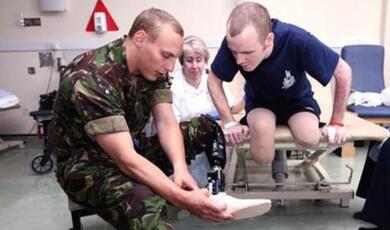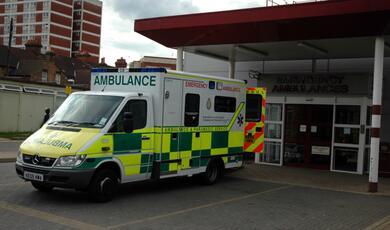Suffer the Little Children: The Gradual Improvement in Child Health has Left Newborns Behind
Share
- Details
- Text
- Audio
- Downloads
- Extra Reading
Chilhood globally, and in Britain, is now safer than at any time in recorded history, with childhood deaths falling rapidly almost everywhere. Neonatal deaths (those in the first 28 days after birth) have fallen, but much more slowly than in later childhood.
Worldwide, we are approaching a point where almost half of all deaths in children under 5 occur in the first 28 days (neonates), and most of these are in the first week of life. In the UK, most of those who die by the age of 20, do so in the first year, and the highest risk is on the day of birth.
This lecture will briefly outline the reasons for the fall in child deaths, and then examine in more detail what we can do to reduce neonatal mortality globally, including low income countries and higher income ones such as in the UK.
Download Text
29 April 2015
Suffer the Little Children: Gradual Improvement in Child Health has Left Infants Behind
Professor Christopher Whitty
In Thomas Gresham's day a child in London was lucky to reach its first birthday. Globally childhood mortality has substantially improved everywhere, and in the last two decades this is a global improvement. The remarkable reduction in global child mortality over the last two decades has however not been matched by reductions in the mortality of newborns. Neonatal mortality (deaths in the first 28 days) have also declined everywhere, but because the decline is relatively considerably slower the proportion of deaths in children which occur in the first 28 days of life are steadily increasing. In much of Asia more than 50% of all children under the age of five who die already do so in the first 28 days of life and in Africa it is already around a third (Figure 1 and 2, both from Liu et al, The Lancet). This proportion is on current trends likely to increase. In high-income countries similar trends are seen: infant mortality (children under 1 year) has decreased much faster than neonatal mortality.
Figure 1. Childhood mortality in South Asia.
Figure 2. Childhood mortality in Africa.
In all settings a high proportion of deaths in neonates are in the first seven days, and the highest proportion in the first 24 hours after birth. In the UK and other industrialised countries neonatal deaths have steadily been falling; rates of neonatal mortality now in the UK are less than half of what they were twenty years ago (Figure 3, Office for National Statistics 2015).
Figure 3. Infant mortality (children up to 1 year) in the UK over 20 years.
Neonatal mortality rates / 1000 (UNICEF 2015, median)
• Japan 1.0
• Finland 1.3
• UK 2.8
• USA 4.0
• China 7.7
• Brazil 8.4
• India 29
• Nigeria 37
• Pakistan 42
A large gap between neonatal deaths rates in low and middle income countries, and neonatal deaths in the developed world currently exists. These are largely avoidable deaths; richer countries avoid them. The great majority of the interventions that could reduce this gap in mortality are simple, cheap and achievable in low intensity settings. This lecture will lay out some of the ways in which we could bring down global neonatal mortality substantially. Given the major contribution this has to child mortality this would be a significant and irreversible advance for human health. As with all the major advances considered in this lecture series on health at the extremes of life big changes are made up of multiple small, evidence-based interventions combining to have a substantial effect. It will them go on to consider public health interventions in high-income countries.
For convenience the lecture will divide the times there can be interventions into:
i. before conception;
ii. when the mother is pregnant;
iii. in premature births;
iv. during childbirth itself and;
v. after childbirth care.
In each of these we can do simple and effective things which will reduce neonatal mortality. A 50 minutes lecture cannot be comprehensive, so this will discuss illustrative examples of the kinds of intervention which are readily available in each period. The talk will concentrate on the places where the burden of disease is highest.
Before conceptionthe simplest intervention is to provide contraception to allow women to be able to space births. Birth spacing of less than two years is associated with small-for-dates babies (they are physically small and light on the day they are born) and prematurity, and both are strongly associated with increased mortality. A second example of pre-conception intervention is folic acid, either as a supplement or fortifying food. Neural tube defects- with different degrees of severity called anencephaly, encephalocoele, and spina bifida, are some of the most common congenital defects, strongly associated with neonatal mortality. Used as primary prevention (any pregnant woman) there is a 46-62% reduction in neural tube defects if fortification of food or supplementation is used. Secondary prevention used in women with previous neural tube defects leads to a 70% reduction. In low-income countries 29% of neonatal deaths due to congenital causes is neural tube defects, so in principle folic acid could reduce neonatal deaths by 13%.
During pregnancylooking after maternal health is clearly essential for the sake of the mother. One of the slightly discouraging aspects of considering neonatal treatment over the last twenty years is that those considering maternal health and those considering neonatal health have tended to work in different silos. For many things anything that is good for the mother is good for neonate and vice versa. Good general maternal care which reduces the risk that women will have to have emergency deliveries or emergency caesarean sections benefits both mother and baby.
There are however some other major risks to neonates which can be avoided by active intervention during pregnancy, particularly in the area of infection. Three infections in particular which can be prevented, detected or treated in pregnancy will significantly reduce neonatal mortality.
The first is an old enemy, syphilis. Although much rarer now in high-income countries, globally over 500,000 adverse outcomes are currently caused by maternal syphilis: approximately, 212,000 stillbirths or foetal deaths, 92,000 neonatal deaths and 65,000 preterm or low birth weight infants. Approximately 66% of adverse outcomes occurred in antenatal attendees who were not tested or were not treated for syphilis. It is easy to test for, and if present easy to treat with penicillin (or other antibiotics).
The second is tetanus. Neonatal tetanus caught due to infection at birth, particularly with unsafe birthing practice is common and has an exceptionally high mortality rate. It is a terrible way to die. Vaccinating mothers against tetanus whilst they are pregnant almost completely removes this risk because the protection is passed on to the neonate. Immunization of pregnant women or women of childbearing age with at least two doses of tetanus toxoid reduces mortality from neonatal tetanus by 94%. If this is combined with better birthing practice and good cord care after birth neonatal tetanus can be almost eliminated- and has been for practical purposes in many countries over the last 15 years.
Malaria gets into the placenta of even semi-immune pregnant women in malaria-endemic areas leading to a small placenta (placental insufficiency) and this in turn leads to small babies and anaemic mothers. Placental malaria can be largely prevented by providing bed nets and giving intermittent preventive treatment with standard malaria drugs during pregnancy.
Protecting the mother against malaria, tetanus and treating syphilis are also good for her.
Prematurity causes around 27% of all neonatal deaths- 1 million. It is the dominant cause in high income countries. In low-income countries is it is a smaller proportion, but causes about 6x higher mortality.Mortality due to prematurity is about 1.5 per 1000 births Europe, 10 per 1000 in Africa.
The first key intervention is to give steroids, which help the lungs develop among other things. In babies born at <36 weeks steroids given before the birth reduce mortality by 31%. In middle-income countries they reduce mortality by 53%, morbidity by 37%. Unfortunately coverage of steroids is around 10% in countries with >90% of global neonatal deaths.
Linked to this is the use of magnesium sulphate, known popularly as Epsom Salts. This has a range of uses in pregnancy, including use in fitting in women with eclampsia (a very dangerous pregnancy-associated high blood pressure syndrome). It can also be used to protect the brain of babies born prematurely, and reduce cerebral palsy.
The premature infant once born is at great risk of hypothermia. One major simple recent advance is the use of kangaroo care. This means putting, and keeping, the premature neonate skin-to-skin with the parent inside their clothes (different from putting babies born at term on their mothers chest). This simple intervention reduces mortality in premature babies by around 50% and also reduces other serious illness.
Turning to the birth process itself the period of birthing is potentially extremely dangerous for both mother and baby. The ability to deliver safely and then resuscitate the child where necessary is the key to minimising the risk. The great majority of neonatal deaths around the day of delivery of children could be avoided with simple resuscitation that does not require any equipment.
The first thing to consider is care of the umbilical cord. Cleaning this with the antiseptic chlorhexidine leads to a 23% reduction in neonatal mortality on top of the advantages of standard clean birthing practice. There may also be advantages to clamping the cord slightly later (1-5 minutes) than conventional practice.
Of 136 million babies born annually, around 10m require assistance to breathe. Most of these only require simple stimulation such as rubbing, or very basic resuscitation. 814,000 neonatal deaths result from intrapartum-related events in term babies (often known as “birth asphyxia”). Neonatal resuscitation training in facilities reduces term intrapartum-related deaths by 30%. Immediate newborn assessment and stimulation would reduce both intrapartum-related and preterm deaths by 10%. Facility-based resuscitation would prevent a further 10% of preterm deaths. Community-based resuscitation would prevent further 20% of intrapartum-related and 5% of preterm deaths.
Surgical interventions such as Caesarean section will always be needed in some cases to save mother or newborn. It is not just the surgical procedure itself that matters; getting the anaesthetic right is also important. Some, such as ketamine, are associated with increased mortality.
In the four weeks following delivery the major avoidable risk to most neonates is sepsis. Even with excellent birthing practice neonates with their immature immune system are exposed to large numbers of bacteria as part of the birth process. Sepsis is relatively easy to manage if it is recognised using standard broad spectrum antibiotics.Trials suggest all-cause reduction in mortality 25% with oral antibiotics and around 40% for pneumonia-specific mortality. Injectable antibiotics confer even better protection than oral in this setting.
Along with things we should do more of there are many things we need to do less of. Many traditional practices, including medical practices, are at best useless and sometimes dangerous. These include fluid and food intake restriction, routine intravenous fluids, early bathing of the neonate, routine separation from mother, fundal pressure to facilitate second stage labour, routine suctioning of the babies mouth, application of various substances to the cord, pre-lacteals, artificial infant milk formula and other breast-milk substitutes.
Promoting all of these interventions in a way that works would massively reduce the rate of neonatal mortality globally and would mean that most low and middle income countries would have neonatal mortality rates that came much closer to those in developed countries. There is a legitimate question- why do we fail, when the interventions are so easy, cheap and evidence-based? The reasons are complex, but include the fact that changing medical and traditional practice is hard, health system strengthening is easier to say than do, and there is a chronic shortage of trained staff (meaning midwives rather than doctors).
The final improvements do require much more high intensity medicine, and include neonatal intensive care or drugs such as surfactants in prematurity, now standard practice in higher-income countries. This does not mean, however, that all of the risks of neonatal mortality and high intensity areas are solved in developed countries. Indeed there is almost a 4x difference in neonatal mortality rates between well-run high-income countries with good healthcare. There also remain major at-risk groups where it seems likely we will see improvements- for example twins and other multiple births have much higher (6x) rates of neonatal mortality in the UK than do single babies.
Turning specifically to the UK, as a typical high-income country with a universal health system, there were 2,686 infant deaths in 2013. The overall infant mortality rate is 3.8 deaths / 1,000 live births. In 1983 the rate was 10.1, so there has been a 62% fall. In the UK, just as in developing countries however, the neonatal survival rate has improved more slowly than later infancy and childhood. The neonatal mortality rate fell by 54%, from 5.9/1,000 in 1983, to 2.7/1,000 live births in 2013. The postneonatal mortality rate fell by 72% over the same period, from 4.3/1,000 live births in 1983, to 1.2 in 2013.
Smoking and obesity are particular risks especially for prematurity. The UK already has high rates of smoking in pregnancy and rising obesity compared to other countries with better neonatal mortality rates, and rates of obesity in young women are rising. In addition women who are higher risk than previously (eg with congenital heart disease) are more likely to be giving birth than previously. This rise in high-risk pregnancies is obviously a good thing for the mothers, but they are risker in terms of birth outcome.
There are in addition to these public health priorities a number of medical interventions which are likely to change obstetric and neonatal care. Some important ones, which are discussed in the lecture are:
• New Non-Invasive Prenatal Testing (NIPT) allowing for genetic abnormalities to be detected with lower risk.
• The rise of near-patient rapid tests for infectious and other diseases.
• Risk stratification- making low-risk pregnancy non-medical.
• Drug companies becoming less risk-averse in pregnancy allowing for disease-modifying drugs. Currently pregnancy is very under-served.
Neonatal mortality globally is such a large proportion of childhood deaths tackling it must be a priority. It is desirable, but as this lecture shows also achievable by combining simple and available interventions.
Professor Christopher Whitty, April 2015
Part of:
This event was on Wed, 29 Apr 2015
Support Gresham
Gresham College has offered an outstanding education to the public free of charge for over 400 years. Today, Gresham College plays an important role in fostering a love of learning and a greater understanding of ourselves and the world around us. Your donation will help to widen our reach and to broaden our audience, allowing more people to benefit from a high-quality education from some of the brightest minds.


 Login
Login







